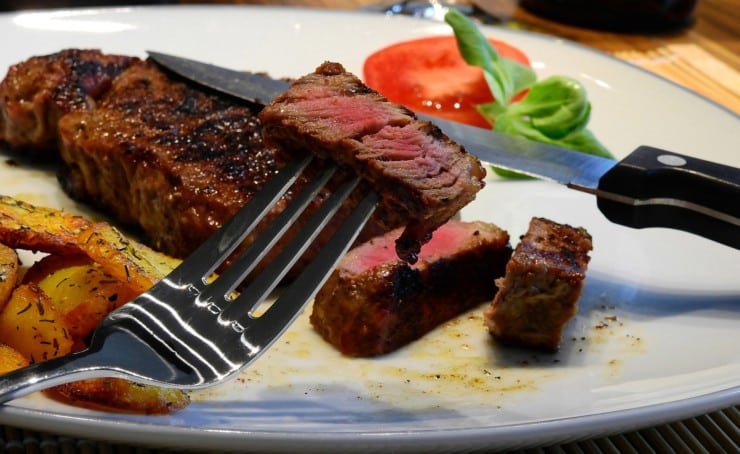Can You Eat Lamb Medium Rare?
There are numerous inquiries surrounding lamb. Is it safe to consume medium rare?
What is the risk? How do you properly cook it so that it is safe to eat but still has that great medium rare flavor?
And what about after eating lamb- do you have to poop? All of these questions and more will be answered in this post.
Can You Eat Lamb Medium Rare?

Yes, you can eat lamb medium-rare. There are a few risks associated with eating lamb medium-rare, but it will be safe to eat if it is cooked properly.
In the United States, lamb is usually eaten medium-rare. This means that there will be a pink inside along with some brown on the outside of your meat.
Lamb has been around for thousands of years, so it definitely qualifies as an old-school way to eat this delicious animal protein.
What Temperature Is Medium-Rare for a Rack of Lamb?
The recommended temperature for a medium-rare rack of lamb is 145 degrees Fahrenheit. Use a meat thermometer to ensure that the internal temperature is 145 degrees Fahrenheit.
How Can I Tell if a Lamb Is Cooked
Use a meat thermometer to check for doneness. Please insert it into the thickest part of the roast, as stated above, the temperature should be 145 degrees Fahrenheit.
If there’s no pink remaining, then remove it from the oven and let it rest. If there’s pink flesh, then it’s not cooked all the way through, and you should put it back in the oven.
How to Properly Cook Medium Rare Lamb

Before cooking your lamb, defrost it. You can do this by letting it cool off at room temperature or by dipping it in slightly warm water.
This will help it cook more evenly. The amount of fat on your piece of meat will help determine the temperature to be used and the amount of time it should cook.
- Roast leaner cuts in a hotter oven at about 425 degrees Fahrenheit for about 20 minutes.
- Bake leaner cuts in a hotter oven at around 400 degrees Fahrenheit for approximately 30 minutes
- Roast fattier pieces of lamb longer and at lower temps of around 350 degrees Fahrenheit
- Bake fattier pieces on a lower oven setting, then turn the heat up to 400 For about 45 minutes until they develop some browning on the outside.
Risks Involved When Eating Medium Rare Lamb Meat
Some people, especially those with meat allergies, can experience severe allergic reactions to lamb meat
- Can contain harmful bacteria: Raw or undercooked lamb meat may also have high levels of bacteria like E. coli which causes food poisoning.
- Skin irritation: Can also cause skin irritation and itching.
- Blood poisoning: Can lead to blood poisoning or even death in some cases. This occurs when the bacteria enter the bloodstream.
- Swelling: This can also cause extreme swelling, especially in the face and neck.
- Nausea: Can also cause severe nausea and vomiting because of the bacteria. This happens when the bacteria enters the digestive system and causes it to become inflamed, resulting in vomiting.
- Diarrhea: Can also cause severe diarrhea. This occurs when the bacteria enters the digestive system and causes it to become inflamed, resulting in a watery, foul-smelling stool.
- Fever: Can also cause a high fever as a result of infection.
What Is Lamb Intolerance?
It can be caused by ingesting raw or undercooked lamb meat. This is due to an enzyme in the animal called papain which breaks down proteins into smaller amino acids during digestion.
These amino acids can then cross the intestinal barrier and enter the bloodstream.
Symptoms of Lamb Intolerance:
- Nausea
- Vomiting
- Diarrhea
- Abdominal pain
- Headache
- Rash
- Joint pain
Is Lamb Healthier Than Beef?
It depends. If it is grass-fed and organic, then yes. But if it’s not, then beef might be a better option.
Grass-fed and organic meat is healthier for you because it has a higher omega-three fatty acid content than conventionally raised meat.
This means that it contains less saturated fat and cholesterol, which are both linked to heart disease.
Safe Practices for Lamb Meat
- Make sure you wash your hands thoroughly with soap and water before and after handling lamb meat.
- Make sure to clean all surfaces and utensils that come in contact with the meat.
- Do not drink or eat anything after handling raw lamb meat.
- Keep the meat refrigerated at all times.
- Do not let the meat sit out for more than two hours or one hour if the temperature is above 90 degrees Fahrenheit.
- Never freeze lamb meat.
- Do not place lamb meat on the top row in the fridge because juices may drip from it and contaminate other foods in the refrigerator.
Meat That You Should Not Be Served Undercooked
Not all meat can be safely served undercooked. A few examples are:
- Poultry
- Pork
- Beef
- Mince
- Offal, including liver
- Rolled joints of meat
- Kebabs
- Sausages
Frequently Asked Questions
Why Do We Use Lamb Instead of Beef for Steak Burgers?
It’s important to note that this is not the same as medium-rare beef. The reason why we use lamb instead of beef for our steaks or burgers is that it has less fat content and therefore fewer calories.
Why Do I Have to Poop After Eating Steak?
It could be because of the high amount of protein in red meat; when you eat a lot of protein, your body has to work hard to break it down.
This can cause an increase in the production of stomach acid, which can lead to an upset stomach or diarrhea.
What Is the Amount of Protein in Red Meat?
Red meat contains approximately 22 grams of protein per three-ounce serving, and this is about 24% of the daily value for a person on a 2000 calorie diet.
Final Thoughts
Lamb is an excellent source of protein, and it’s also high in vitamin B12, niacin, and zinc. So, if you’re looking for a healthy and delicious way to enjoy some protein, then give lamb medium-rare a try.
Do not be afraid to try out this old-school way of cooking lamb today and share the joy with your family and friends.







